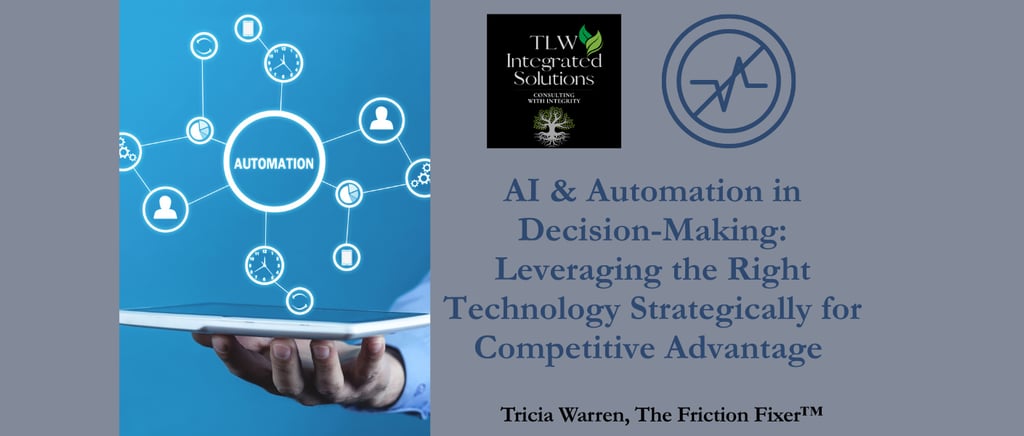AI and Automation in Decision-Making: Leveraging the Right Technology Strategically for Competitive AdvantageYour Post title


Beyond the Buzz: Making AI and Automation Strategic
It feels like overnight that AI and automation have evolved rapidly from futuristic buzzwords to integral tools for effective decision-making. The truth is, the evolution has been years in the making—but despite the growing maturity of these technologies, many organizations still struggle to harness them strategically.
In my work with leaders across industries, one pattern stands out: success isn’t about chasing the latest AI trend. It’s about aligning the right technology with the right organizational goals at the right time. Without that alignment, even the most advanced tools can become expensive distractions instead of competitive advantages.
In one engagement with a global client, leadership had invested heavily in AI-driven platforms and automation tools. On paper, it looked impressive. In practice, the results were underwhelming—efficiencies stalled, decision-making barely improved, and frustration grew.
The problem? Technology was deployed broadly without being anchored to the most critical friction points in the business. This scattershot approach, while well-intentioned, diffused impact and created change fatigue. What was needed was a targeted strategy: identify the most pressing operational bottlenecks, then apply AI and automation precisely where they could deliver immediate, meaningful results.
This isn’t an outlier. It’s a common scenario—and it underscores why strategic alignment is essential.
Why Strategic Alignment Matters
According to a 2024 report by a Big Four consulting firm, organizations that strategically integrate AI and automation into decision-making processes see, on average:
30% improvement in operational efficiency
25% faster decision-making compared to peers who implement without a clear strategy.
These gains are not the product of bigger budgets or flashier tools—they’re the result of intentional, targeted deployment.
If your organization wants to harness AI and automation for smarter, faster decisions, consider these steps:
Clarify Strategic Objectives First. Before touching technology, get crystal clear on your top business priorities. Select tools that directly support those goals—avoid adopting tech just because it’s new or popular.
Start Small and Scale Thoughtfully. Pilot initiatives in clearly defined areas where you can measure impact quickly. Early wins build organizational confidence and provide the data you need to expand successfully.
Prioritize Human-AI Collaboration. AI and automation should amplify human intelligence, not replace it. Equip your teams with training and guardrails so they can combine human judgment, creativity, and ethics with machine efficiency.
Leaders: Understand the Assignment
Strategic alignment & unity doesn’t happen by accident—it’s intentional and modeled from the top. Leaders visible support and clear communication are crucial in fostering organizational buy-in. Leaders must actively champion these initiatives, ensuring teams see technology not as an IT project but as a business-critical transformation. According to Gartner (2024), organizations with proactive leadership engagement in AI and automation strategies are 40% more likely to achieve measurable business outcomes.
Your role is to create clarity, foster collaboration, and ensure alignment from the C-suite to the front line.
When thoughtfully integrated, AI and automation can transform decision-making, speed up execution, and create a culture of agility and responsiveness. But the competitive advantage won’t come from technology alone—it will come from leaders who understand where and how to apply it for maximum impact.
How Are You Being Strategic?
Is your organization using AI and automation to solve its most critical challenges, or are the tools spread too thin to make a difference? How are you ensuring ethical use, data security, and alignment with your strategic priorities?
I’d love to hear what’s working for you—and what lessons you’ve learned—so we can continue this conversation and help each other drive operational excellence!
